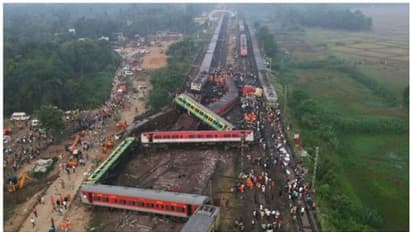Coromandel Express crashed at 128 kmph, was not on main line: Initial probe

Synopsis
The Coromandel Express mistakenly entered the loop line and collided with a parked goods train instead of staying on the main line near the Bahanagar Bazar station. Sources said the collision caused the coaches of the Bengaluru-Howrah Superfast Express to overturn after crashing into the scattered coaches of the Coromandel Express
Initial investigation into the crash of three trains in Odisha's Balasore district, in which over 280 lives were lost, has indicated that the Coromandel Express train mistakenly entered the loop line and collided with a parked goods train instead of staying on the main line near the Bahanagar Bazar station.
Sources said the collision caused the coaches of the Bengaluru-Howrah Superfast Express to overturn after crashing into the scattered coaches of the Coromandel Express on the adjacent track.
The speed of the Coromandel Express was approximately 128 kmph, while the Bengaluru-Howrah Superfast Express was running at about 116 kmph. The report regarding the incident has been submitted to the Railway Board.
Loop lines are constructed within station areas, such as the Bahanagar Bazar station, to facilitate smoother train operations and accommodate more trains. These loop lines are generally 750 meters long, allowing the accommodation of full-length goods trains with multiple engines.
Both trains were carrying around 2,000 passengers. While a comprehensive investigation is underway, no authorities have mentioned the possibility of sabotage thus far.
The national railway system has initiated a thorough investigation into the Odisha train crash, which will be led by the Commissioner of Railway Safety, South Eastern Circle. The Commissioner of Railway Safety operates under the Ministry of Civil Aviation and is responsible for investigating such accidents.
The national railway system has also clarified that the anti-train collision system "Kavach" was not implemented on the route. The crash involved the Bengaluru-Howrah Superfast Express, the Shalimar-Chennai Central Coromandel Express, and a goods train.
While earlier sources suggested a signalling failure as a potential cause of the crash, railway officials have stated that it is still unclear whether the Coromandel Express entered the loop line and collided with the stationary goods train or if it derailed first and then struck the parked train after entering the loop line.
According to a preliminary investigation report, the signal for the up main line was given and removed for train number 12841, but the train entered the loop line, collided with the goods train, and derailed. Meanwhile, train number 12864 passed through the down main line, and two of its coaches derailed and overturned.
Sudhanshu Mani, the former general manager of the Integral Coach Factory in Chennai and the leader of the team that created the first Vande Bharat train, initially ruled out any error on the part of the two train operators involved in the tragedy. He stated that the primary reason for the high number of casualties was the initial derailment and the unfortunate timing of the second passenger train approaching from the opposite direction at a high speed.
The preliminary probe report said the signal was given and taken off for the up main line for train number 12841, the train entered the loop line, dashed with the goods train and derailed. In the meantime, train number 12864 passed through the down main line and two of its coaches derailed and capsized, the report said.
Mani, prima facie, ruled out any error on the part of the two locomotive pilots involved in the tragedy and said the primary reason for the mass casualty is the first derailment and the unfortunate timing of the second passenger train, which came from the other direction at a very high speed.
Mani stressed that if only the first train had derailed, the LHB coaches would not have overturned, resulting in a lower number of casualties.
"While it is currently impossible to speculate on the exact cause of the first train's derailment, there is no evidence of a Signal Passed at Danger (SPAD) incident, where the driver ignores signals. According to the data logger, the train was on the correct path as the signal was green," Mani stated.
In February, in response to a head-on collision between two goods trains in Uttar Pradesh, the railway system initiated an extensive safety campaign to prevent accidents such as derailments and train operators overshooting signals.
As part of this campaign, senior officers from the Railway Board, zonal railways, and divisions were instructed to conduct thorough reviews of working practices, visiting various sections, crew facilities, maintenance centres, and work sites. The objective was to enforce safe operation and maintenance practices to prevent accidents and unusual incidents.
Sri Prakash, a former Member (Traffic) of the Railway Board, also commented on the limited ability of the second train's driver to mitigate the damage due to high speed.
"The driver's capacity to apply brakes and stop the train depends on the available time and the train's speed. Passenger train derailments are rare compared to goods trains. The findings of the investigators regarding the cause of the derailment will be of utmost importance," he explained.
Odisha Train Accident: 'I will never forget the bloodbath on tracks'
Stay updated with the Breaking News Today and Latest News from across India and around the world. Get real-time updates, in-depth analysis, and comprehensive coverage of India News, World News, Indian Defence News, Kerala News, and Karnataka News. From politics to current affairs, follow every major story as it unfolds. Get real-time updates from IMD on major cities weather forecasts, including Rain alerts, Cyclone warnings, and temperature trends. Download the Asianet News Official App from the Android Play Store and iPhone App Store for accurate and timely news updates anytime, anywhere.